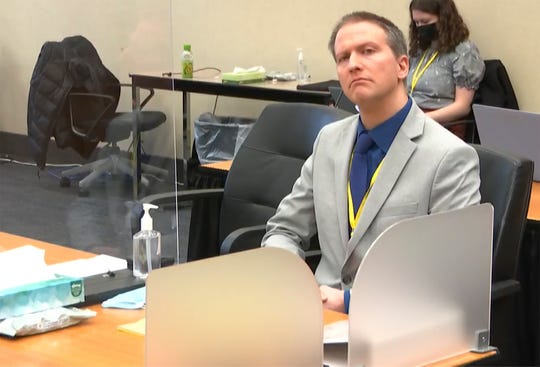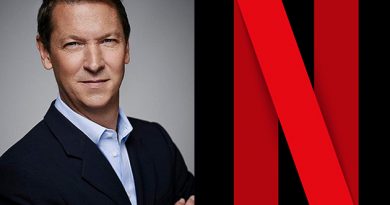Assault or ‘reasonable’ policing? Takeaways from Derek Chauvin murder trial closing statements.
MINNEAPOLIS – Attorneys made their closing statements in the murder trial of former police officer Derek Chauvin on Monday, leaving jurors to make sense of two entirely different arguments to determine whether Chauvin is guilty of murder or manslaughter in George Floyd’s death last May.
Throughout the trial, prosecutors argued that Chauvin’s knee – pressed against 46-year-old Floyd’s neck while he was handcuffed and face-down on the street – led to his death by loss of oxygen. The defense argued underlying heart issues and the methamphetamine and fentanyl in his system caused Floyd’s death while he struggled with police.
Both sides used still images, video clips and visual aids as they talked the jury through the charges Chauvin, 45, faces: second- and third-degree murder and second-degree manslaughter.
In this image from video, former Minneapolis police Officer Derek Chauvin listens as his defense attorney Eric Nelson gives closing arguments as Hennepin County Judge Peter Cahill preside Monday, April 19, 2021, in the trial of Chauvin at the Hennepin County Courthouse in Minneapolis. (Photo: AP)
During the statements, Chauvin took notes on a yellow legal pad, as he has done for weeks. So did the jurors.
As lead defense attorney Eric Nelson told jurors Chauvin acted like any other “reasonable officer” during his closing arguments, Chauvin took his surgical mask off, giving jurors a look at his entire face.
Get notified when there’s a verdict: Sign up for text messages of updates in the Derek Chauvin trial
An angry mob or witnesses-to-be?
Prosecutors described the bystanders watching Chauvin restrain Floyd as horrified strangers brought together to witness what happened and testify before the jurors.
Prosecutor Steve Schleicher concluded his argument with an appeal to jurors as “random members of the community, all converged by fate at one single moment in time to witness” what happened. Though they were powerless at the time, he said, they were empowered to bring their testimony to jurors.
Defense attorney Eric Nelson referred to those bystanders as an angry, threatening, distracting crowd that prevented Chauvin from noticing the moment Floyd took his last breath.
Nelson played for jurors video of the moment that, according to an expert for the prosecution, Floyd lost consciousness. Noting how off-duty firefighter Genevieve Hansen had approached officers, Nelson said Chauvin pulled his Mace out and focused on her, rather than on Floyd beneath him.
Medical care for Floyd
The prosecution said officers violated the Minneapolis Police Department’s “duty of care” policy, which required them to render aid to Floyd as soon as possible when he exhibited medical distress.
“George Floyd’s final words on May 25, 2020, were: ‘Please, I can’t breathe.’ He asked for help with his very last breath,” Schleicher said. “All that was required was compassion.”
Schleicher said “sanctity of life” is a cornerstone of the department’s use-of-force policy, and as first responders, officers are taught basic first aid, including CPR and chest compressions.
Chauvin “didn’t follow the hundreds of hours of training he had. He didn’t follow the department’s rules or do CPR,” Schleicher said. “He knew better, he just didn’t do better.”
Members of the Minnesota National Guard stand at an intersection in downtown Minneapolis shortly before jurors were set to begin deliberations in the murder trial of former police officer Derek Chauvin in the death of George Floyd. (Photo: Trevor Hughes, USA TODAY)
Chauvin should have known how to handle someone in crisis, Schleicher said, noting that Floyd told police about his anxiety and claustrophobia as they tried to cram him into the back of a squad car. Just because he couldn’t comply doesn’t mean he was resisting, he said.
Rather than care for Floyd, Schleicher said, officers were “picking rocks out of the tire and commenting on the smell of a man’s feet.”
Nelson argued that Chauvin and the other officers did as they were trained by calling for an ambulance and alerting authorities of the severity of the situation. He said they couldn’t do more because the scene wasn’t safe.
Defense attorney Eric Nelson argued that Derek Chauvin's actions were 'reasonable' during closing arguments in the trial of the former police officer.
USA TODAY
He said Chauvin did not have decades of medical experience like Dr. Martin Tobin, a pulmonologist and expert witness for the state who had the luxury to watch the video footage for hours. Nor was Chauvin taught that the kick of Floyd’s leg was his brain’s last gasp from oxygen loss, Nelson said.
Instead, Nelson said, a “reasonable officer” – a phrase he repeated, based on a Supreme Court case in 1989 on use of force – is simply taught to use additional force to overcome a suspect’s resistance, which explained why an officer pressed Floyd’s leg down when it rose up.
“It is not uncommon for suspects to feign or pretend to have a medical emergency while being arrested,” Nelson said.
He played videos showing Floyd saying he couldn’t breathe before he was on the ground, suggesting that those cries under Chauvin’s knee didn’t mean he was truly in distress.
9:29 versus 16:59
Schleicher repeatedly cited the “nine minutes and 29 seconds” of the bystander video, showing moments in which Chauvin had his knee placed on top of Floyd’s neck and back.
“George Floyd begged until he could speak no more, and the defendant continued this assault,” Schleicher told the jurors.
“When he was unable to speak, the defendant continued,” Schleicher said. “When the defendant was unable to breathe, the defendant continued. Beyond the point he had a pulse. The defendant continued this assault, nine minutes and 29 seconds. When the ambulance arrived, the ambulance was here, and the defendant continued, the defendant continued. He would not let up.”
Nelson argued that “the nine minutes and 29 seconds ignores the previous 16 minutes and 59 seconds” when officers were dealing with Floyd.
Michael Jones watches closing arguments in the Derek Chauvin trial outside the Hennepin County Government Center on April 19, 2021 in Minneapolis, Minn. (Photo: Stephen Maturen, Getty Images)
He focused on Floyd’s interactions with officers before being under Chauvin’s knee. He noted that Chauvin, as a “reasonable officer,” had to take into account the entire situation because “human behavior is unpredictable, and nobody knows it better than a police officer.”
“Someone can be compliant one second and fighting the next,” Nelson said.
The prosecution has not challenged the officers’ early interactions with Floyd as excessive. Their expert witness testified that their restraint of Floyd became excessive and unreasonable only when Floyd was on the ground.
Nelson showed body camera footage of Chauvin standing back while other officers tried to deal with Floyd. Nelson noted that Chauvin only moved in when they couldn’t handle him.
A focus on Chauvin versus Floyd
Schleicher reminded jurors that Chauvin is on trial, not the police, and Floyd is not on trial for his drug use or anything else.
“This is not a prosecution of the police, it’s a prosecution of the defendant,” Schleicher said. “And there’s nothing worse for good police than bad police, who doesn’t follow the rules, who doesn’t follow training.”
Referring to the images of the horrified crowed and the look on Chauvin’s face as he had his knee on Floyd’s neck, Schleicher told jurors that Chauvin “chose pride over policing.”
Schleicher called the knee restraint “unnecessary, gratuitous and disproportionate, and Chauvin did it on purpose. This was not an accident. He did not trip and fall and find himself on George Floyd’s neck.”
Nelson portrayed Chauvin as concerned by Floyd’s size and the fact that he was “on something,” as he told a bystander.
Nelson argued that Floyd’s drug use was a crucial part of the evidence, and that officers have seen people come to after being unconscious and become violent.
Nelson told jurors that people under the influence of certain drugs can possess greater-than-normal strength, and Chauvin was responding to the information he had at the time.
Policing versus an assault
The crux of whether Chauvin will be found guilty of murder is whether his restraint of Floyd was an assault or standard policing, which Nelson said can be “lawful but awful.”
Schleicher told jurors that in this case, it was “just awful.” He told jurors the police were called for an alleged counterfeit $20 bill, and no evidence was presented to show Floyd knew it was fake.
Calling Chauvin’s actions a “shocking abuse of police power,” Schleicher said Chauvin’s actions, which were observed by a 9-year-old, were “not policing” but “an assault.”
He told jurors they must ask themselves: “But for the defendant’s actions, pushing him down, would George Floyd have died that day?”
Nelson called the entire situation “tragic,” arguing that “all of the evidence shows that Mr. Chauvin thought he was following his training. He was in fact following his training. He was following Minneapolis Police Department policies. He was trained this way. It all demonstrates a lack of intent.”
Under the Fourth Amendment and a 1989 U.S. Supreme Court case, jurors should consider what a reasonable officer would do, having the same knowledge and being placed in the same situation to determine whether the force used by an officer is excessive.
Follow Tami Abdollah, a national correspondent for criminal justice who is covering the Chauvin trial, on Twitter @latams
Source: Read Full Article


